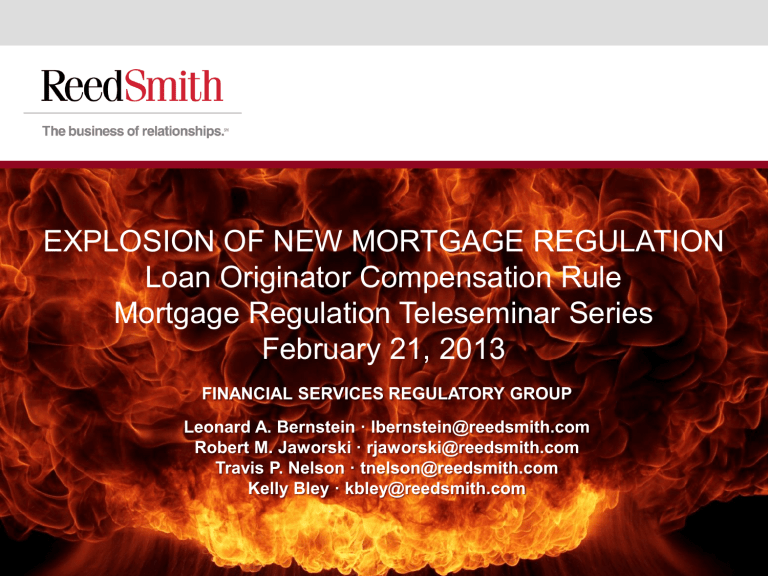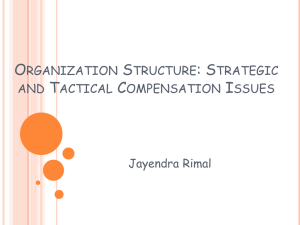Presentation Slides

EXPLOSION OF NEW MORTGAGE REGULATION
Loan Originator Compensation Rule
Mortgage Regulation Teleseminar Series
February 21, 2013
FINANCIAL SERVICES REGULATORY GROUP
Leonard A. Bernstein · lbernstein@reedsmith.com
Robert M. Jaworski · rjaworski@reedsmith.com
Travis P. Nelson · tnelson@reedsmith.com
Kelly Bley
· kbley@reedsmith.com
BACKGROUND AND EFFECTIVE DATES
Reg Z § 1026.36
• FRB Proposal (August 2009)
• Dodd-Frank § 1403 (July 2010)
• FRB Final Rule (September 2010) – did not implement
§ 1403
• CFPB Final Rule (January 20, 2013)
• Effective Date (January 10, 2014, except for arbitration/credit insurance provisions which become effective June 1, 2013)
2
KEY COMPONENTS
New LO
Qualification and
Disclosure
Requirements
LO Compensation:
Restrictions and
Clarifications
• New rules regarding profit-sharing plans
New requirements for policies and procedures
Expanded LO record-keeping requirements
New prohibitions on mandatory arbitration clauses and financing of credit insurance
3
SCOPE
• Closed-end consumer credit transactions secured by a dwelling
• First- or subordinate-lien
• Includes closed-end reverse mortgages
• Certain provisions (arbitration and credit insurance) also apply to HELOCS secured by principal dwelling
4
PENALTIES – CIVIL ACTIONS
3-Year Statute of Limitations
Consumers can sue creditors, LOOs and/or individual LOs
• Expands liability to LOOs/LOs
For violations of LO comp restrictions, consumers can recover:
• Actual and statutory ($400-$4,000) damages
• Enhanced HOEPA damages (for material violations, sum of all finance charges and fees paid by the consumer)
• Except that LOO and individual LO liability capped at 3 times amount of compensation received in connection with loan
• Costs and attorney’s fees
5
PENALTIES – CIVIL ACTIONS
(Continued)
Violations of the LO comp restrictions also provide consumers with defense to foreclosure
• New, additional remedy under Dodd Frank
• No statute of limitations
• In nature of set-off or recoupment
• If > 3 years after closing, damages capped as of end of 3year period
No enhanced HOEPA damages for violations of LO
Qualification/Disclosure, Arbitration, and Credit Insurance provisions
6
PENALTIES – ADMINISTRATIVE ACTIONS
Who has jurisdiction?
• Prudential bank regulators: depositories ≤ $10 billion in assets
• CFPB: depositories > $10 billion in assets, and nonbank covered persons
• Agencies can undertake lengthy investigations
• Role of state attorneys general
Available Relief
• Permanent and temporary cease and desist orders
• Fines
• Prohibition from working in the banking industry (for prudential regulators)
7
“LOAN ORIGINATOR” DEFINITION
§ 1026.36(a)(1)
Person, who in expectation of direct or indirect compensation performs any of the following:
• Takes an application
• Arranges or assists in obtaining credit
• Negotiates for another person
• Otherwise obtains or makes a loan
• Advertises that it can perform one of above
8
“LOAN ORIGINATOR” DEFINITION
(Continued)
Loan Origination activities include:
• Referring consumer to a loan originator
• Arranging a credit transaction
• Advising on specific credit terms; or collecting supporting information on consumer’s behalf
• Presenting specific credit terms
• Advertising that one can perform LO activity.
9
“LOAN ORIGINATOR” DEFINITION
(Continued)
“Individual loan originators” (“individual LOs”):
• Employees of loan originator organization
• Employees of creditor
• If they meet the LO definition
• Could be independent contractors
• Natural persons
“Loan originator organization” (“LOO”) – any LO that is not an
“individual loan originator”
10
“LOAN ORIGINATOR” DEFINITION
(Continued)
“Table funding” creditor is a “loan originator”
“Creditors” are NOT LO’s if:
• Creditor uses its own funds, either
• Via a bona fide warehouse line of credit
• Or via its own deposits
LO qualification and LO disclosure requirements: all creditors are “loan originators”
11
“LOAN ORIGINATOR” DEFINITION
Not loan originators…
LOAN ORIGINATOR does not include:
• Person performing purely administrative or clerical tasks
• Employee of manufactured home retailer who does not take application or advise on credit
• Real estate broker that performs only RE activity, unless compensated by creditor or LO
• Seller financer (see criteria on next slides)
• Servicer modifying loan unless “refinance”
• Third party advisors, like accountants, FA’s.
12
“LOAN ORIGINATOR” DEFINITION
Not loan originators …
(Continued)
Managers, administrative and clerical staff : “LO” status is not triggered when responding to inquiries:
• To supply an application form,
• Accept completed form,
• Deliver the application to an LO or creditor,
• Generally describe application process or form
• Provide general information
• Provide LO or creditor contact info
• Providing general guidance on credit criteria
13
“LOAN ORIGINATOR” DEFINITION
Not loan originators …
(Continued)
Loan Processing : “LO” status is not triggered for creditor or LO employee or agent that:
• Compiles credit application packages
• Verifies information; requests supporting docs.
• Arranges settlement or other logistics
• Provides info unrelated to credit terms
• States that written offer has been sent
14
“LOAN ORIGINATOR” DEFINITION
Not loan originators …
(Continued)
Underwriting, Pricing : “LO” status is not triggered for creditor or LO employee that:
• Underwrites w/o consumer contact
• Approves credit terms w/o consumer contact
• Establishes credit pricing; provided others offer to public
15
“LOAN ORIGINATOR” DEFINITION
Not loan originators…
(Continued)
“SELLER FINANCE” EXCLUSION – 3 PROPERTIES
• Person provides seller financing for 3 or fewer properties in any 12 month period
• Person has not constructed property
• Financing:
• Fully amortizing
• Determine “in good faith” ability to repay; either under regulations or streamlined approach in Commentary
• Fixed rate, or 5 year ARM with reasonable caps and widely available index:
• safe harbor: 2 % annual and 6% lifetime
16
“LOAN ORIGINATOR” DEFINITION
Not loan originators…
(Continued)
“SELLER FINANCE” EXCLUSION – 1 PROPERTY
• Natural person, estate or trust
• Person provides seller financing for 1 property in any 12 month period
• Person has not constructed property
• Financing:
• No negative amortization
• Fixed rate, or 5 year ARM with reasonable caps and widely available index;
• safe harbor: 2 % annual and 6% lifetime
17
“LOAN ORIGINATOR” DEFINITION
“PRODUCING MANAGERS”
• Managers who “sometimes” engage in LO activity
• “Producing managers” are loan originators
• Does not matter if compensation not transaction-specific
• Manager can approve terms and set terms w/o being deemed an LO, provided only an LO communicates with consumer
18
LO QUALIFICATION REQUIREMENTS
Standards ( § 1026.36(f))
• Scope : “Loan originators” include all creditors for this rule; rule covers transactions secured by dwelling
• TILA Liability : “ Imposes a TILA obligation on all loan originator organizations – mortgage brokers and both nondepository and depository institution mortgage creditors – to ensure that their individual loan originators are licensed or registered to the extent required under the SAFE Act ”
19
LO QUALIFICATION REQUIREMENTS
Standards ( § 1026.36(f))
(Continued)
Nonbanks: Imposes threat of TILA civil liability/enforcement if:
• LO fails to comply with state licensing/foreign qualification
• LO fails to ensure each individual LO is “SAFE Act” licensed
• Bureau’s SAFE ACT Rule, 12 CFR 1008 (“Reg H”) sets forth minimum licensing standards for states
20
LO QUALIFICATION REQUIREMENTS
Standards ( § 1026.36(f))
(Continued)
Bank/Subsidiary Individual LO’s: For each individual LO that is a bank employee, bank must:
• OBTAIN criminal background check, credit report and info about administrative, civil or criminal findings
• DETERMINE that individual LO has no felony conviction, and has demonstrated “financial responsibility, character & general fitness”
• TRAIN – provide periodic training re applicable law
• Timing – For employees hired on or after 1/10/14, and for any individual who “likely” does not meet standards above.
• SAFE Act Rule – 12 CFR 1007 (“Reg G”) for bank LO’s
21
LO QUALIFICATION REQUIREMENTS
Standards ( § 1026.36(f))
(Continued)
• Can check individual’s status: www.nmlsconsumeraccess.org
• Subsequent reviews not required unless new knowledge
• “Financial responsibility”: judgments, tax liens, delinquencies; not required to consider medical debts
• “Character & general fitness”: acts of dishonesty (including employment applications), disciplinary actions.
• SAFE HARBOR: For “financial responsibility, character and general fitness” standard, establish and comply with written procedures for that individual.
• Training – applies regardless of individual’s hiring date.
22
LO DISCLOSURE REQUIREMENTS
( § 1026.36(g))
• Scope: Consumer credit transactions secured by dwelling
• “Loan Document” Disclosure: LOO must include name and
NMLSR ID (if there is one), for both LOO and individual LO.
• “Loan Documents”: application, note, mortgage; NOT TILA or
RESPA disclosure, pending the integration process.
• TILA Liability – presume liability if disclosure missing
23
LO COMPENSATION RESTRICTIONS
Three prohibitions
1. No comp based on loan terms
( § 1026.36 d 1 )
• No compensation may be paid to or received by a LO based on loan term (or other factor that serves as a proxy for loan term)
2. No “dual compensation”
( § 1026.36 d 2 )
• No comp may be paid to or received by a LO from both consumer and party other than consumer for same loan (with certain exceptions)
3. No improper
“steering”
( § 1026.36(e))
• LO may not
“steer” consumer to a loan that provides greater comp to LO unless loan is “in the consumer’s interest”
24
LO COMPENSATION RESTRICTIONS
Three prohibitions
(Continued)
Restrictions apply to compensation paid to individual LOs, producing managers, and LOOs
“Compensation”: Any financial or similar benefit, e.g., salaries, commissions, bonuses, awards of stock, merchandise, services, trips, etc., but not:
• Payment to LO for bona fide and reasonable charges passed on to independent 3rd party; e.g.
credit reports
• Payment to LOO or LOO affiliate for bona fide and reasonable charges for non-loan origination activities
• “Average charge pricing” (but “upcharge” is comp)
25
LO COMPENSATION RESTRICTIONS
No comp based on loan terms
(
§ 1026.36 d 1 )
• Prohibition applies to both consumer-pay and lender-pay
• Expansion: current rule - only lender pay
• Prohibition applies to compensation that is based on:
• A “term of a transaction”
• Terms of multiple transactions by individual LO, OR
• Terms of multiple transactions by multiple individual LOs
( e.g.
, comp based on mortgage-related profits)
• Term of a transaction” includes any right or obligation of the parties, except under certain circumstances amount of credit extended
26
LO COMPENSATION RESTRICTIONS
No comp based on loan terms
(Continued)
Comp based on any of the following permitted:
• Amount of credit extended provided comp is determined as fixed % (w/ or w/o dollar cap and/or floor)
• LO’s overall loan volume
• Long-term performance of LO’s loans;
• Hourly Rate of pay for actual hours worked
• Whether existing or new customer
• Fixed dollar amount for every loan
• LO pull-through rate
• Quality of LO’s files (accuracy and completeness)
27
LO COMPENSATION RESTRICTIONS
No comp based on loan terms
(Continued)
Comp based on any of the following “terms” not permitted:
• Loan interest rate
• APR
• Type of collateral ( e.g
., condo, co-op, detached home, manufactured housing)
• Existence of prepayment penalty
• Pooled comp where LOs originate loans with different terms and earn different commissions
• “Proxy” for a loan term
28
LO COMPENSATION RESTRICTIONS
No comp based on loan terms
(Continued)
“Proxy”: Factor, not a “term of a transaction”, which:
• Consistently varies with a “term of a transaction” over a significant number of transactions, and
• LO has ability, directly or indirectly, to add, drop or change when originating the loan.
Examples:
• Different comp for portfolio (all fixed-rate 5-year balloons) v. non-portfolio (30-year loans at higher fixed-rates) = proxy
• Different comp for loans secured by property in VT v MA
(even if rates differ) ≠ proxy
29
LO COMPENSATION RESTRICTIONS
No comp based on loan terms
(Continued)
Pricing concessions
• LO’s comp may be decreased to defray unforeseen settlement cost or increase in disclosed settlement cost
• LO’s or LOO’s comp may not be decreased to meet a competitor’s better offer, or avoid high cost loan trigger, or for other reason
30
LO COMPENSATION RESTRICTIONS
What about profit-sharing plans?
Designated tax-advantaged defined contribution plan:
• Most common type: 401(k) plan
• Definition: “A plan which provides for an individual account for each participant and for benefits based solely on the amount contributed to the participant’s account,” adjusted for earnings, losses, expenses and allocation of forfeitures
• Meets Internal Revenue Code requirements for taxqualified plans
• Both employee and employer can contribute to employee’s account in the plan
31
LO COMPENSATION RESTRICTIONS
What about profit-sharing plans?
(Continued)
Designated tax-advantaged defined benefit plan:
• Commonly referred to as a pension plan
• Definition: “Any plan which is not a defined contribution plan”
• Meets Internal Revenue Code requirements for taxqualified plans
• Employer contributions are made to the plan to pay an accrued benefit at retirement
• Example: Participant receives monthly benefit payable for life and for the life of his or her spouse
32
LO COMPENSATION RESTRICTIONS
What about profit-sharing plans?
(Continued)
Non tax-advantaged (nonqualified) deferred compensation plan:
• Deferred compensation plan that does not meet Internal
Revenue Code requirements for tax-advantaged plans; subject to Internal Revenue Code Section 409A
• Not subject to the same limitations on contributions as are tax-advantaged plans
• Example: Excess plan (which provides contributions in excess of the amounts permitted under a tax-advantaged defined contribution or defined benefit plan)
33
LO COMPENSATION RESTRICTIONS
What about profit-sharing plans?
(Continued)
Non-deferred profitsbased compensation plan (“Bonus Plan”)
• Bonus plan based in whole or in part on mortgage-related profits
• Compensation received now rather than at retirement
(unlike the tax-advantaged plans)
• Paid now, taxed now
• Distributions may be determined by fixed formula or at discretion of person paying
34
LO COMPENSATION RESTRICTIONS
What about profit-sharing plans?
(Continued)
Individual LO may receive, and person may pay, compensation in the form of a:
• Contribution to a designated tax-advantaged defined contribution plan, provided contribution not directly or indirectly based on terms of the individual LO’s transactions
• Benefit under a designated tax-advantaged defined benefit plan ”
But NOT for contributions to or benefits under a nonqualified deferred compensation plan
35
LO COMPENSATION RESTRICTIONS
What about profit-sharing plans?
(Continued)
Individual LO may also receive, and person may pay, compensation under a Bonus Plan, provided
• Comp not directly or indirectly based on terms of the LO’s covered transactions AND
• Comp paid under plan may not exceed 10% of LO’s total compensation (“10% Limit”), unless LO originated ≤ 10 loans during preceding 12 months
36
LO COMPENSATION RESTRICTIONS
What about profit-sharing plans?
(Continued)
Example: Creditor pays individual LO:
• $15,000 year-end bonus for 2012 (in Jan. 2013)
• $80,000 in commissions (in 2013)
• $10,000 contribution to LO’s 401-K (in 2013)
• $10,000 year-end bonus for 2013 (in Jan. 2014)
Bonus for 2013 satisfies 10% Limit
• Assuming creditor counts 401-K contribution, total comp =
$100,000 ($15,000 bonus for 2012 does not count) → maximum bonus for 2013 = $10,000 (10% of $100,000)
37
LO COMPENSATION RESTRICTIONS
What about profit-sharing plans?
(Continued)
Bonus Plans (subject to 10% Limit) include:
• Quarterly or annual bonuses, trips, other prizes or incentives
Do not include:
• Guaranteed quarterly bonus in specified amount if LO exceeds performance benchmarks ( e.g.
, $1M in originations each month) – bonus earned w/o regard to profits
• Retention bonus budgeted for in advance
38
LO COMPENSATION RESTRICTIONS
What about profit-sharing plans?
(Continued)
• Comp paid under Bonus Plan NOT subject to 10% Limit if plan determined with reference only to profits from nonmortgage-related business “as determined in accordance with reasonable accounting principles”
• More cautious approach may simply be to apply 10% Limit.
• Safe harbor for individual LO who relies in good faith on accounting or statement provided by person who made profits-based compensation determination
39
LO COMPENSATION RESTRICTIONS
No dual compensation
(
§ 1026.36 d 2 )
Rule: If consumer pays LO directly, no LO may receive additional compensation from any other person in connection with the transaction
Exception: If consumer pays LOO directly, LOO may pay commission to individual LO, BUT neither LOO nor individual
LO may receive additional comp from creditor
• Proposal to require “zero-zero” alternative dropped
40
LO COMPENSATION RESTRICTIONS
No dual compensation
(Continued)
Consumer-paid compensation includes:
• Payments to LO out of loan proceeds
• Payments to LO by person other than creditor or affiliate
( e.g., non-creditor seller, builder, home improvement contractor, real estate agent) pursuant to agreement with consumer
41
LO COMPENSATION RESTRICTIONS
No dual compensation
(Continued)
Consumer-paid compensation does not include:
• Payments by consumer to the creditor (direct or out of loan proceeds)
• Funds from creditor that are applied to reduce consumer’s settlement costs (including origination fees paid by creditor to LO) and which are disclosed as “credits” on HUD-1
42
LO COMPENSATION RESTRICTIONS
No improper steering
(
§ 1026.36(e))
Rule: LO may not steer consumer to loan that pays LO more unless loan is “in consumer’s interest”
Safe harbor : Loan is deemed “in consumer’s interest” if LO presents consumer with three specified loan options
43
LO COMPENSATION RESTRICTIONS
No improper steering
(Continued)
Specified loan options are:
• Loan with lowest interest rate
• Loan with lowest interest rate, but no neg. am., prepayment fee, interest-only payments, balloon payment in first 7 years, demand feature or shared equity/shared appreciation feature
• Loan with lowest dollar amount of discount points, origination points or origination fees
• New qualification: If more than one such loan, must offer loan with lowest interest rate
44
LO COMPENSATION RESTRICTIONS
Records Retention ( § 1026.25(c))
• Creditors: Must maintain for 3 years records “sufficient to evidence” all payments to individual LOs and LOOs and compensation agreement that governs each payment.
• LOOs: Must maintain for 3 years:
• records “sufficient to evidence” (a) all comp received from creditor, consumer, or other person, and (b) all comp paid to any individual LO, and
• governing compensation agreement(s)
•
•
Individual LOs: Need not retain these records
What constitutes “sufficient to evidence”?
• Oral agreements: Record retention still applies
45
Policies and Procedures ( § 1026.36(j))
Banks must establish and maintain written policies and procedures to ensure compliance with:
• Restrictions on payments to LOs – 36(d)
• Prohibitions on steering – 36(e)
• LO qualification requirements – 36(f)
• LO disclosure requirements – 36(g)
TILA civil liability attaches for no or inadequate policies
46
Prohibition on Mandatory Arbitration
( § 1026.36(h))
• Scope: Consumer credit secured by a dwelling (including
HELOCs)
• Effective date: June 1, 2013
• Arbitration:
• No mandatory arbitration clauses
• Consumer and creditor may agree – after dispute arises – to use arbitration to resolve
• Waivers:
• No predispute waiver of federal claim
• Waiver of right to trial by jury OK
47
Prohibition on Financing Single-Premium
Credit Insurance ( § 1026.36(i))
• Scope: Consumer credit secured by a dwelling (including
HELOCs)
• Effective date: June 1, 2013
• Creditor may not finance, directly or indirectly, single premium credit insurance
• “Credit insurance” = credit life, credit disability, credit property
• Credit unemployment: May be financed under certain conditions
• Does not apply to mortgage insurance.
48
Final Topic in this Four-Part Teleseminar Series
Escrow Rule; HOEPA/High-
Cost Mortgage Rule;
ECOA Appraisal Rule;
Appraisals for High-Risk
Mortgage Rule
March 7, 2013, Noon (EST)
To access an audio recording and presentation slides from our previous teleseminars, please visit the series website: http://www.reedsmith.com/Financial-Services-Regulatory-Group-
Mortgage-Regulation-Teleseminar-Series/
49
Leonard A. Bernstein
• Founder and chair of the firm's Financial Services Regulatory
Group
• Concentrates his practice in the representation of banks, thrifts, mortgage bankers and finance companies in providing consumer credit compliance advice on federal, Pennsylvania and New Jersey laws and regulations
• The FSR Group addresses credit card, auto finance, deposit, residential mortgage and other retail finance products
• Nationally known for expertise with federal Truth-in-Lending Act,
Real Estate Settlement Procedures Act, and similar laws, and works regularly with federal and state financial services regulators
• Defends class actions and individual claims filed against financial services providers
• Elected to the American College of Consumer Financial
Services Attorneys lbernstein@reedsmith.com
215 851 8143
Philadelphia, PA
609 520 6005
Princeton, NJ
50
Robert M. Jaworski
• Member of the Financial Industry Group and the Financial
Services Regulatory Group
• Focuses on consumer credit compliance and other regulatory issues of concern to banks, thrifts, mortgage bankers, secondary mortgage lenders, finance companies and industry-related trade associations
• A frequent speaker on compliance issues before state and national groups, Bob has authored numerous articles on the subject
• Formerly Chief Editor of Pratt’s Mortgage Compliance Letter ;
Co-Chair of the RESPA/Housing Finance Subcommittee of the
ABA Consumer Financial Services Committee; Chair, New
Jersey Bar Association Banking Law Section; and Member,
Governing Committee of the Conference on Consumer Finance
Law
• Developed and taught courses on federal and state laws and regulations affecting mortgage bankers, brokers, and servicers rjaworski@reedsmith.com
609 520 6003
Princeton, NJ
51
Travis P. Nelson
• Member of the Financial Industry Group and the Financial Services
Regulatory Group
• Former Enforcement Counsel with the Office of the Comptroller of the Currency, U.S. Treasury Department, Washington, D.C.
• Focuses his practice on financial services regulation, enforcement defense, internal investigations, and litigation matters
• Represents clients before federal law enforcement and regulatory agencies, including the OCC, the CFPB, and HUD, as well as various state authorities across the country
• Adjunct faculty teaching Regulation of Financial Institutions at
Villanova University School of Law
•
•
Co-Leader, Reed Smith Financial Institutions Enforcement &
Investigations Task Force
Editor-in-Chief of the Reed Smith Financial Services blog – www.financialregulatoryreport.com
• National President, Office of the Comptroller of the Currency Alumni
Association tnelson@reedsmith.com
609 524 2038
Princeton, NJ
212 549 0236
New York, NY
52
Kelly L. Bley
• Associate in the Tax, Benefits & Wealth Planning Group, where she concentrates her practice in the area of employee benefits law
• Has extensive experience in all aspects of employee benefits law, but her primary focus is on the legal issues associated with tax-qualified plans
• Has represented domestic and international employers of all sizes, both public and private, with regard to compliance with the Internal Revenue Code and ERISA
• Has experience working with governmental plans and not-forprofit plan sponsors
• Routinely represents employers before the Internal Revenue
Service and the Department of Labor
• Regularly counsels employers regarding the complex issues associated with plan administration
• Former in-house counsel for a bank holding company where she served as the head of the Compensation and Benefits Practice
Group for the legal department kbley@reedsmith.com
412 288 7182
Pittsburgh, PA
53








